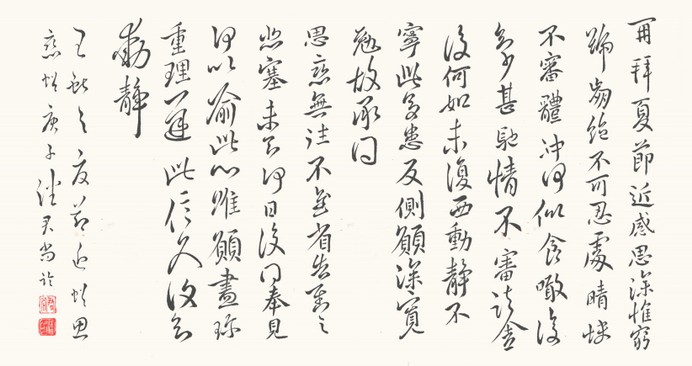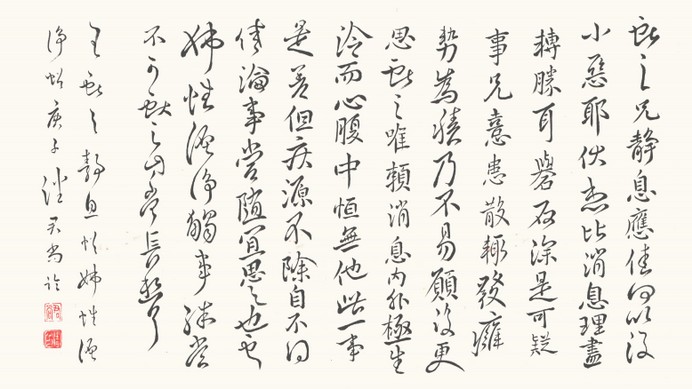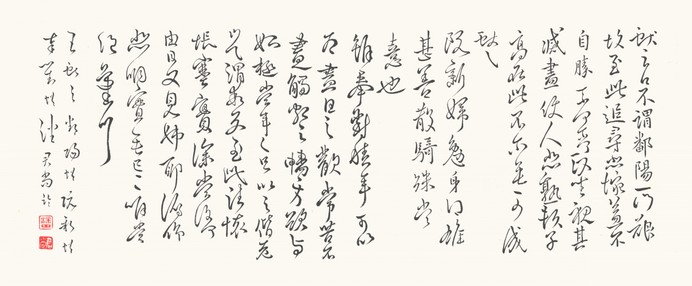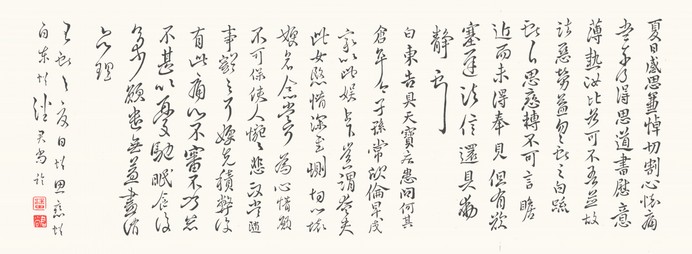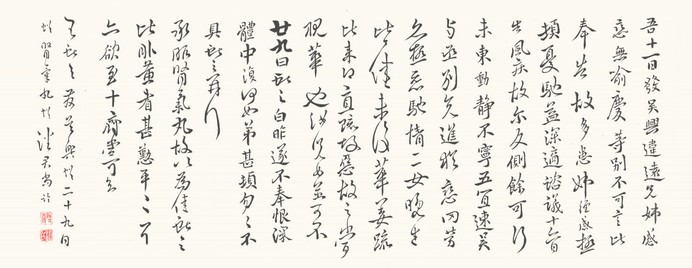Galleries and Translations > Models of Masterpieces > Models of Masterpieces by Wang Xianzhi (part II) 臨王獻之諸法帖 (第二部份)
Models of miscellaneous Exemplary Masterpieces by Wang Xianzhi (part II) 臨王獻之諸法帖 (第二部份)
Historical information
(I)
Wang Xianzhi (王獻之, 344-386AD) was the seventh son of “The Sage of Calligraphy (書聖)” Wang Xizhi (王羲之, 303–361AD). At an early age of seven, his extraordinary talents in calligraphy had already been recognized by his father (七八歲時學書,羲之密從後掣其筆不得,歎曰:「此兒後當復有大名。」)(1). Although he later developed a rather unrestraint and unconventional personality (高邁不羈…風流為一時之冠) (2), his cursive and standard scripts were widely admired (工草隸)(3) for their liberating and serene demeanours (逸氣縱橫)(4). Thus, along with his father, he was regarded as one of the Four Talents (四賢) in the art of Chinese calligraphy(5).
(II)
Despite Wang Xianzhi’s brilliance, his calligraphy was not without criticism. The Book of Jin narrated that his calligraphy lacked strength and sturdiness compared to that of his father (獻之骨力遠不及父)(6). Sun Guoting, in his Narrative on Calligraphy, went even further to chastized his arrogance and thus concluded that his art was undoubtedly inferior to his father’s (子敬之不及逸少,無或疑焉)(7). Such criticisms serve as good reminders that the ultimate foundation of Chinese calligraphy is the refinement of temperaments, not techniques(8).
(III)
The calligraphies presented below are my models of Wang Xianzhi's handwriting found in Chunhua Imperial Archive of Calligraphy Exemplars (《淳化閣帖》). Supposedly, these handwritings were short letters and memos scribed by Wang. Although their authenticities are questionable, they are still often regarded as Exemplary Masterpieces (法帖) for calligraphers to study and observe. In the art of Chinese calligraphy, "帖(pronounced as Tie)" refers to an exemplary work that should be studied by all .
(IV)
Since the originals in the Chunhua Imperial Archive of Calligraphy Exemplars (《淳化閣帖》) can be parts of or whole letters/memos scribed by Wang, translations that are provided below, if available, may not be entirely precise, for they can be interpreted out of context. Further, whether Wang had actually scribed them remains questionable. Accordingly, scholars should be wary of using these as authentic historical references.
____________________________________________
(1) 房玄齡,《晉書》卷八十王羲之列傳. 北京:中華書局, 1974, p.2105.
(2) Ibid., p.2104.
(3) Ibid., p.2104.
(4) 張懷瓘《書斷》. 《歷代書法論文選》. 上海: 上海書畫出版社, 1979, p.164.
(5) KS Vincent Poon & Kwok Kin Poon, A Narrative on Calligraphy by Sun Guoting Revised and Enhanced Edition 英譯書譜 增訂版. Toronto: The SenSeis, 2019, pp.9-10.
(6) 房玄齡,《晉書》卷八十王羲之列傳. 北京:中華書局, 1974, p.2106.
(7) KS Vincent Poon & Kwok Kin Poon, A Narrative on Calligraphy by Sun Guoting Revised and Enhanced Edition 英譯書譜 增訂版. Toronto: The SenSeis, 2019, p.15.
A model of Xia Jie Jin Tie (夏節近帖) and Si Lian Tie (思戀帖)
35 X 66 cm
Click to Enlarge. Reserved, not available in shop.
Xia Jie Jin Tie (夏節近帖):
Original Classical Chinese: 再拜,夏節近,感思深。惟窮號崩絶,不可忍處。晴快。不審體中何似。食噉復多少。甚馳情。不審諸舍復何如。未復西。動靜不寜。此多患反側。願深寛勉。故承問。
English: NA. The entire phrase may not be translated, for the context in which it was written is unknown or uncertain.
Si Lian Tie (思戀帖):
Original Classical Chinese: 思戀無往不慰。省告。對之悲塞。未知何日復得奉見,何以喻此心。唯願盡珍重理。遲此信反。復知動靜。
English: NA. The entire phrase may not be translated, for the context in which it was written is unknown or uncertain.
A model of Jing Xi Tie (靜息帖) and Zi Xing Chan Mian Tie (姉性纏綿帖)
35 X 62 cm
Click to Enlarge. Reserved, not available in shop.
Jing Xi Tie (靜息帖):
Original Classical Chinese: 獻之白,兄靜息當佳,何以複小惡耶?伏想比消息理盡,轉勝耳。礜石深是可疑事。兄熹患散,輒發癰勢。為積乃不易。願複更思。獻之惟賴消息,內外極生冷,而心腹中恒無他。此一事,是差。但疾源不除,自不得佳。論事當隨宜思之也。獻之白。
English: NA. The entire phrase may not be translated, for the context in which it was written is unknown or uncertain.
Zi Xing Chan Mian Tie (姉性纏綿帖):
Original Classical Chinese: 姉性纏綿,觸事殊當不可。獻之方當長愁耳。
English: NA. The entire phrase may not be translated, for the context in which it was written is unknown or uncertain.
A model of Po Yang Tie (鄱陽帖), Ruan Xīn Fu Tie (阮新婦帖), and Feng Dui Tie (奉對帖)
35 X 85 cm
Click to Enlarge. Reserved, not available in shop.
Po Yang Tie (鄱陽帖):
Original Classical Chinese: 獻之白,不謂鄱陽一門,艱故至此。追尋悲惋,益不自勝,奈何奈何。 政坐視其滅盡。使人悲熟。賴子高在此,不爾無可成。獻之白。
English: NA. The entire phrase may not be translated, for the context in which it was written is unknown or uncertain.
Ruan Xīn Fu Tie (阮新婦帖):
Original Classical Chinese: 阮新婦勉身。得雄甚善。散騎殊當憙也。
English: NA. The entire phrase may not be translated, for the context in which it was written is unknown or uncertain.
Feng Dui Tie (奉對帖):
Original Classical Chinese: 雖奉對積年,可以為盡日之歡。常苦不盡觸類之暢,方欲與姉極當年之足,以之偕老。豈謂,乖別至此,諸懷悵塞實深。當復何由日夕見姉耶。俯仰悲咽,實無已已,惟當絕氣耳。
English: NA. The entire phrase may not be translated, for the context in which it was written is unknown or uncertain.
A model of Xia Ri Tie (夏日帖), Si Lian Tie (思戀帖), and Bai Dong Tie (白東帖)
35 X 95 cm
Click to Enlarge. Reserved, not available in shop.
Xia Ri Tie (夏日帖):
Original Classical Chinese: 夏日感思兼悼,切割心懷。痛當奈何奈何。得思道書,慰意。薄熱。汝比各可不。吾並故諸惡勞,益勿勿。獻之白疏。
English: NA. The entire phrase may not be translated, for the context in which it was written is unknown or uncertain.
Si Lian Tie (思戀帖):
Original Classical Chinese: 獻之白。思戀轉不可言,瞻近而未得奉見,但有歎塞。遲諸信還具動靜。獻之白。
English: NA. The entire phrase may not be translated, for the context in which it was written is unknown or uncertain.
Bai Dong Tie (白東帖):
Original Classical Chinese: 白東告具。天寶疾患。問何其倉卒乏子孫,當欣倫早成家。以此娛 上下。豈謂,奄失此女,愍惜深至,惻切心懷。㛐哀念當可為心,情願不可保。使人惋惋悲。政當隨事豁之耳。㛐先積弊,復有此痛心。不審不乃惡不。甚以憂馳。眠食復多少。願遣無益,盡消息理。
English: NA. The entire phrase may not be translated, for the context in which it was written is unknown or uncertain.
A model of Fa Wu Xìng Tie (發吳興帖), Er Shi Jiu Rì Tie (廿九日帖), and Shen Qi Wan Tie (腎氣丸帖)
35 X 90 cm
Click to Enlarge. Reserved, not available in shop.
Fa Wu Xìng Tie (發吳興帖):
Original Classical Chinese: 吾十一日發吳興,違遠兄姉。感戀無喻。慶等別不可言。比奉告。故多患。姉經感極頓。憂馳益深。適諮議十六日告。風疾故爾反側!餘可。行未東。動靜不寧。吾宜速。吳興丞別先進,猶戀罔。勞亦極惡。馳情。二女晚生皆佳。未復華姜疏。比來得直疏。故惡。故云當視華也。汝兒女並可不。
English: NA. The entire phrase may not be translated, for the context in which it was written is unknown or uncertain.
Er Shi Jiu Rì Tie (廿九日帖):
Original Classical Chinese: 廿九日獻之白。昨遂不奉。恨深。體中復何如。弟甚頓。勿勿不具。獻之再拜。
English: NA. The entire phrase may not be translated, for the context in which it was written is unknown or uncertain.
Shen Qi Wan Tie (腎氣丸帖):
Original Classical Chinese: 承服腎氣丸,故以為佳。獻之比服黃耆,甚勤,平平耳。亦欲至十齊。當可知。
English: NA. The entire phrase may not be translated, for the context in which it was written is unknown or uncertain.
